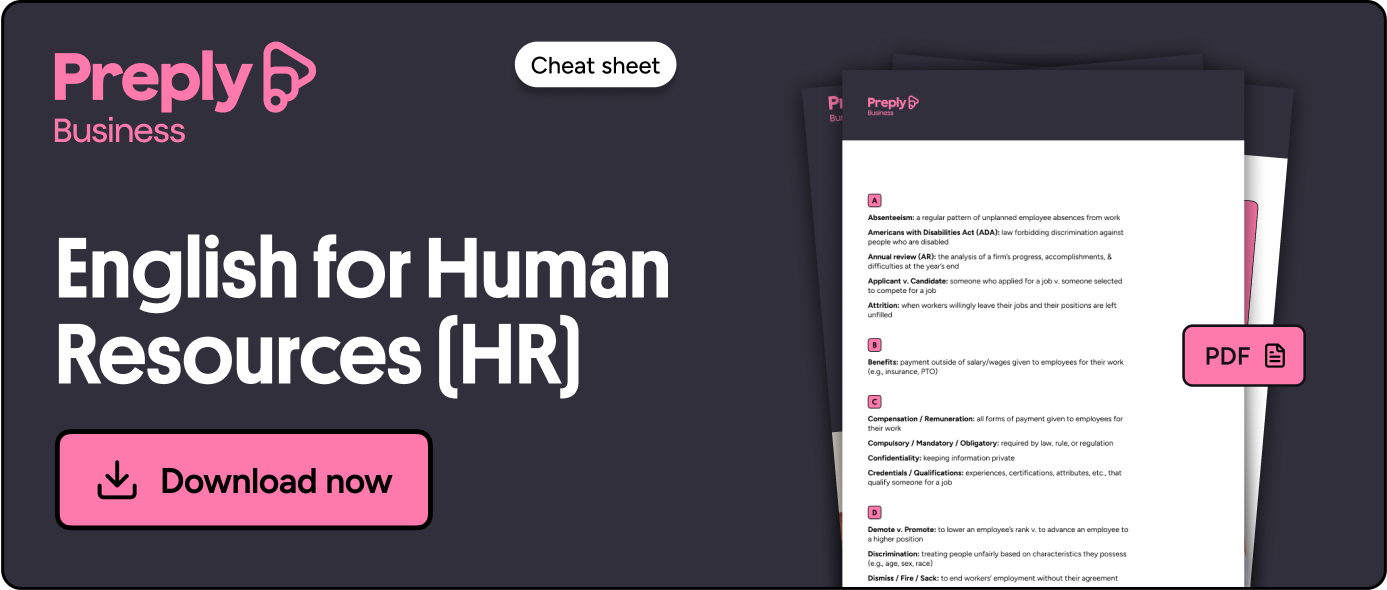Top 60 Human Resources (HR) abbreviations & acronyms

Explore Preply’s guide to HR abbreviations and acronyms, featuring the most commonly used HR terms accompanied by handy, in-context examples.
Whether you’re a part-time freelancer, a full-time employee, or a first-time job seeker, you’ll undoubtedly encounter human resources (HR) teams throughout your career. In short, HR is a special department that’s responsible for hiring and training an organization’s personnel.
The use of abbreviations and acronyms in business is customary, but the practice is even more widespread in the world of HR.
Human resources abbreviations and acronyms are useful for condensing lengthy documents and quickly conveying information to others. However, trying to understand and remember such a large quantity of HR terms can be quite difficult.
To help you master critical HR terminology abbreviations and acronyms, we’ve compiled a list of the 60 most relevant human resources terms for you to learn.
List of common HR abbreviations and acronyms
The following list of HR acronyms and abbreviations presents the term, shares what it stands for, and provides an example sentence to help you understand how the term works in context.
A
AAR: After Action Review
“Sally scheduled an AAR when the project was completed so that she and her team could meet to discuss what happened, why it happened the way it did, and how the process could be improved in the future.”
ACR: Application Completion Rate
“The organization realized that its application process was highly ineffective after calculating an incredibly low ACR, meaning most candidates who began a job application did not successfully finish it.”
ADA: The Americans With Disabilities Act
“According to ADA regulations, our company is legally required to ensure that you’re able to perform your job duties in our work environment, so please share any accommodations you might need to work in our offices on this form.”
AD&D: Accidental Death & Dismemberment
”Full-time staff are eligible for AD&D coverage at this company, which means insurance will pay a benefit if they lose their life, eyes, limbs, speech, or hearing in an accident—even if the accident occurs when they’re not working.”
AR: Annual Review
“To conduct an AR, managers sit down with each team member to talk about the employees’ work performance and accomplishments throughout the previous year, as well as the professional goals the staff has for the upcoming year.”
ATS: Applicant Tracking System
“After submitting your cover letter and resumé on our online portal, you’ll get an automated confirmation email from the ATS—a software program that enables us to track job candidates as they move through the recruiting and hiring process.”
B
BIK: Benefits in Kind
“Our organization offers many BIK, or non-monetary forms of compensation, to our employees—like meal vouchers, childcare assistance, temporary lodgings, retirement plans, health insurance plans, and more.”
BOD: Board of Directors
“The startup’s BOD comprises a diverse array of former CEOs and executives who are collectively responsible for providing guidance, establishing a strategic plan, and overseeing daily operations and management.”.
C
C&B: Compensation and Benefits
“Mariah carefully read the full description of C&B laid out in her contract so she could clearly understand all the perks and rewards she would be granted as an employee at this new company.”
CHRO: Chief Human Resources Officer
“Also referred to as the Chief People Officer, the CHRO is part of a business’s executive team and serves as the organization’s most senior HR leader.”
COLA: Cost of Living Adjustment
“Every year, Jill’s organization provides a COLA, which increases employees’ salaries by a small percentage to account for inflation in housing, healthcare, energy, food, and/or transportation costs.”
CPH: Cost Per Hire
“Our company hired 40 people last year, and we spend approximately $70,000 on the hiring process annually; therefore, our CPH is about $1,750.”
D
DEI: Diversity, Equity, and Inclusion
“It’s essential to implement DEI initiatives that promote collaboration among employees from distinct backgrounds because this strategy often increases innovation and enriches the workplace.”
E
EEO: Equal Employment Opportunity
“Our business practices follow EEO laws, meaning we hire, terminate, and award raises based on employees’ performance and ability—not on the basis of external factors like gender, race, nationality, age, political affiliation, religion, etc.”
ELC: Employee Life Cycle
“To monitor an employee’s entire professional journey with an organization, HR managers will track them through the seven stages of the ELC: attraction, recruitment, onboarding, engagement, development and training, talent retention, and offboarding.”
EOB: Explanation of Benefits
“A few weeks after his doctor’s appointment, Javier received an EOB from his insurance provider showing what he was charged, what insurance covered, and what he’ll owe when he’s billed.”
ESO: Employee Stock Option
“Our ESO plan provides excellent financial equity compensation: you’ll be able to buy 100 shares of company stock at $10 each during your first three months of employment here.”
F
FSA: Flexible Spending Account
“Amari’s employers offer an FSA in their benefits package for employees who wish to set aside money from their wages (before they’re taxed) to pay for healthcare and dependent care costs.”
FT: Full-Time
“In the U.S., FT employees are typically classified as individuals who work between 32 and 40 hours a week, and they are often afforded various company benefits.”
FTE: Full–Time Equivalent
“If an organization considers 40 hours a week to be FT, then an employee working 40 hours a week has an FTE of 1.0, and an employee working 20 hours a week has an FTE of 0.5.”
FY: Fiscal Year
“Allison’s firm set their FY to run from July 1 to June 30, during which time the company will monitor its financial transactions for accounting purposes.”
H
HRD: Human Resource Development
“The team in charge of HRD establishes a clear vision to cultivate employees’ skills and knowledge through organization-wide trainings and other initiatives.”
HRLY: Hourly
“The wage range for the Human Resources Assistant position is $23.00-$25.00/HRLY and is paid on a biweekly schedule.”
HSA: Health Savings Account
“Like FSAs, HSAs enable you to set funds aside to pay for certain medical expenses before being taxed, yet you can’t contribute as much money to FSAs as you can to HSAs.”
I
IRA: Individual Retirement Account
“Amir’s employer matches 3% of the amount he contributes to his IRA, , which will help him save even more money for retirement without being taxed.”
J
JD: Job Description
“According to the JD, the role requires the candidate to possess strong computer skills and notes that preference will be given to those who are familiar with Adobe Suite.”
L
L&D: Learning & Development
“A critical function of HR is to develop and implement an L&D strategy, which is designed to grow employees’ skills, knowledge, and abilities to help meet the company’s key business objectives.”
LOA: Leave of Absence
“If you wish to take an LOA, you should alert your supervisor and the HR department with sufficient advance notice as you’ll be taking more than a few weeks off of work unpaid.”
LOS: Length of Service
“At our organization, loyal employees are rewarded for their LOS by being able to accrue additional vacation leave every year.”
LTD: Long-Term Disability
“After Kenny injured his back, his LTD insurance plan provided him with a portion of his income to help cover his and his family’s living expenses until he could work again two years later.”
LWOP: Leave Without Pay
“Marisa had already used all of her paid vacation time and sick leave, so when she got the flu and needed three days off of work, she requested LWOP.”
M
MOP: Measure Of Performance
“When conducting your annual review, managers will use several different MOPs to assess how well you execute your work tasks, such as your average commission earnings or the average return rate of your customers.”
MQs: Minimum Qualifications
“In most job descriptions, there’s a list of MQs that outline the most basic education, professional experience, knowledge, and skills a candidate must have to perform the job.”
N
NDA: Non-Disclosure Agreement
“Many organizations have employees sign an NDA during the onboarding process, which is a legally binding agreement between workers and their employers in which staff members consent to not sharing certain company practices, secrets, and/or information with competitors.”
NE: Non-Exempt
“Because José is an NE worker, he is protected by the Fair Labor Standards Act (FLSA) and entitled to overtime pay if he works more than 40 hours per week—unlike exempt employees who are paid the same salary regardless of how many hours they work.”
O
OE: Open Enrollment
“Once a year, employees are eligible to sign up for or make changes to their company-sponsored health insurance during a period called OE.”
OPL: Optimum Productivity Level
“The cost of getting a new hire to their OPL, or ideal level of productivity on the job, involves expenses such as recruitment, onboarding, training, compensation, benefits, etc.”
OT: Overtime
“If you are a non-exempt employee, be careful about working more than your contracted hours per week because some companies do not have the budget to pay their employees extra when they work OT.”
P
PA: Performance Appraisal
“At the end of every quarter, supervisors will conduct a PA for each employee; in this process, managers observe staff members, evaluate their work and efficiency, and then provide them with feedback.”
PERT: Project Evaluation and Review Technique
“Camila used a PERT chart to demonstrate the various stages and specific tasks of the upcoming project, reminding the team of critical deadlines and emphasizing the project’s most important milestones.”
PIP: Performance Improvement Plan
”If your manager determines that you’re not meeting your work goals, they’ll likely give you a PIP, which will identify your weaknesses and skills gaps, and set clear expectations for future behavior.”
PM: Performance Management
“To ensure effective PM, employees, managers, and HR must continuously engage in activities that develop workers’ skills and ensure they can execute their job to the best of their ability.”
PPM: Policy and Procedures Manual
“When in doubt, Ria consults her company’s PPM to better understand the rules, regulations, operational procedures, business processes, and policies she must fulfill and uphold as an employee.”
PT: Part Time
“As a PT employee, Grace works less than 30 hours a week and doesn’t receive the same benefits as FT employees, but she has a better work-life balance.”
PTO: Paid Time Off
“Generally speaking, the longer you work for a company, the more PTO you accrue; this means you have more days to get paid while away from work for reasons like vacation, sick leave, jury duty, parental leave, disability, etc.”
Q
QR: Quarterly Review
“Every three months, Oludame’s company conducts a QR to assess each employee’s job performance, accomplishments, and difficulties throughout the quarter, and support them in overcoming challenges they face.”
R
RIF: Reduction in Force
“Following a merger, the organization imposed a RIF and terminated five of its permanent positions, negatively impacting employee morale.”
ROI: Return on Investment
“The HR department decided to measure the training ROI of a customer satisfaction course for customer service representatives by comparing the cost of the training with client satisfaction ratings following the initiative.”
RPO: Recruitment Process Outsourcing
“Some companies use RPO to handle all or some of their talent acquisition and recruitment needs, which means they transfer these responsibilities to a third-party provider.”
RTW: Return to Work
“After employees have been out of work due to an illness or injury, our RTW program helps transition them back into work on a temporary, limited, or light duty basis until they can perform at full capacity.”
S
SE: Salaried Exempt
“Working as an SE employee, Yajie will still earn the same income annually, regardless of whether she works overtime or takes two weeks of vacation in the summer.”
SNE: Salaried Non-Exempt
“Charlie is SNE, meaning he has a fixed annual salary, but he must clock in and out of work daily to account for his earnings and is entitled to overtime pay.”
SOH: Source of Hire
“After tracking the SOH for successful job candidates over the previous year, the firm found that 30% of their new hires found out about the job opening from social media, 40% came from their career page, 10% from job boards, and 20% from employee referrals.”
T
TM: Talent Management
“As our HR department is in charge of TM, they are responsible for identifying high-potential workers and developing initiatives and training for them so they remain engaged, motivated, and loyal.
TNA: Training Needs Analysis
“The sales team did not reach their sales goals last quarter, so we’ll conduct a TNA to determine what knowledge and/or skills the employees must improve on to perform at a higher level.”
TSP: Thrift Savings Plan
“The TSP is a retirement savings and investment plan that allows employees working for the government to receive the same or comparable benefits as those working for private employers.”
TTF: Time to Fill
“The average TTF for organizations across all industries is 42 days, meaning it takes about 42 calendar days to hire a new candidate from the time the position is created to the time the candidate accepts the job offer.”
U
UCI: Unemployment Compensation Insurance
“If you are terminated due to circumstances beyond your control—such as company budget cuts—you are likely eligible for UCI, which pays you a percentage of your lost earnings while you search for a new job or other forms of assistance.”
W
WC: Workers’ Compensation
“If Marta gets injured or becomes ill while on the job, her company’s WC program ensures that she is paid her wages while recovering and that her medical bills are covered.”
WFH: Work From Home
“The organization’s WFH policy is three days a week in office, which means employees must work in the office for three days a week minimum but can perform their job duties remotely, like at home or in a coffee shop, the other two days of the week.”
Final words
Although business jargon can be confusing, reviewing these popular human resource acronyms and abbreviations will help you in the long run. This is especially true considering most HR terms are directly connected to your health, long-term savings, and professional development.
If you’re still feeling a little out of your depth but eager to effectively navigate the corporate world, why not try Preply’s corporate English training or its Business English course? Preply even offers a Business English for human resources course, which is specifically built for HR professionals.
Working with one of Preply’s expert tutors in 1-on-1 virtual classes, you’ll receive tailor-made lessons and customized instruction so you can grasp the fundamentals of business English as efficiently as possible.
Soon enough, these HR abbreviations and acronyms—along with other corporate lingo—will feel second nature to you. Then you’ll be the one breaking them down for your colleagues—not us!
Next article

Business jargon: a survival guide for the office
Discover a complete guide to business jargon for HR professionals with Preply Business. Find entertaining learning resources & useful exercises to do yourself & share with your teams!
Previous article

6 Best business English training courses for executives [2024]
Discover the best executive English courses with Preply Business & which training options will provide executives with the business English skills they need.








